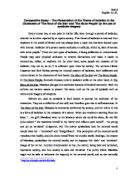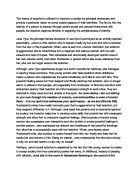The Presentation of the Theme of Isolation in the Characters of The Hour of the Star and The Bone People by the use of symbolic imagery
Rahul
English A1 SL
Comparative Essay – The Presentation of the Theme of Isolation in the Characters of ‘The Hour of the Star’ and ‘The Bone People’ by the use of symbolic imagery
Every human has, at one point in his/her life, been through a period of isolation, wherein he is either rejected by or rejects society. This theme of isolation is now and then explored in the world of fiction and has always been a topic that has been looked upon with interest. Isolation of a person means seclusion or solitude, which is, lack of contact with other people. There are two types of isolation, it being deliberate or unintentional. People may seek physical seclusion to remove distractions and make it easier to concentrate, reflect, or meditate. On the other hand, some people are unaware of the isolation they are in, as in; it is enforced upon them by society. The authors Clarice Lispector and Keri Hulme portray an unusual amount of isolation, both deliberate and unintentional, in the characters of their books The Hour of the Star and The Bone People. In The Bone People, Kerewin chooses to be in isolation while on the other hand, in The Hour of the Star, Macabea plunges into seclusion because of societal constraint. Both the authors use various means to present this issue, such as the use of symbols such as mirrors and imagery of vampires.
Mirrors are used as symbols in both books to portray the seclusion of the characters. They are a reflection of one self, and therefore give rise to self-awareness. In The Hour of the Star, Macabea is constantly confronted by society, and her refute to this is a form of isolation in the company of a mirror. When she receives a warning from her boss: “…the girl [Macabea] went to the lavatory where she could be alone, for she felt quite shaken.” she examines herself in the mirror and reflects upon herself – “so young and yet so tarnished” (Lispector, 24). The mirror symbolises how the external world would view her – “tarnished” and “insignificant”. This perception of the external world translates into reality, and she shuns herself from the outside world. Rodrigo, the creator of Macabea, symbolises the external world, and he imposes this ‘dark’ and ‘tarnished’ image of her on her. Another interpretation is that, the mirror, being dark and tarnished, represents society, and thus society is dark and tarnished. The purity within Macabea might not be able to withstand the impurity in the external world, and so she naturally requires to place herself in solitude. Another instance is when she does not turn up for work under the pretext of having a tooth extracted. The next day, when her roommates leave for work – “she [Macabea] could enjoy at long last the greatest privilege of all: solitude” (Lispector, 41). This is the one time in the book when she really expresses herself, as she waltzes around the room with ‘reckless abandon’ (Lispector, 41). She then resorts to the mirror to ‘confront’ herself. Normally disgusted by her own image, she feels elation now on confronting herself in front of the mirror, something she has never felt before. “To confront herself was a pleasure that she had never before experienced… Even looking at herself in the mirror was no longer quite so alarming…” (Lispector, 41). Thus, it is inferred from this that her happiness or depression in a state of solitude is subjective to the context, as in, the events that precede this state of isolation. It is these events that force her into seclusion in the first place.







